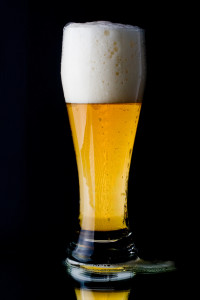High intake of alcohol is associated with a number of detrimental effects on the human body. Amongst these effects is the damaging influence that alcohol can have on the heart. High alcohol intake is associated with a condition called alcoholic cardiomyopathy which is a form of dilated cardiomyopathy. Here we take a look at this condition in a little more detail.
What is alcoholic cardiomyopathy (ACM)?
Alcoholic cardiomyopathy is a clinical condition that the heart becomes enlarged and weak due to the high intake of alcohol. Not all individuals who consume large amounts of alcohol develop alcoholic cardiomyopathy. However, as  far as causes of dilated cardiomyopathy go, alcohol still remains high up in the list.
far as causes of dilated cardiomyopathy go, alcohol still remains high up in the list.
In other words, amongst all individuals who suffer from dilated cardiomyopathy, the condition appears to be more common in those who consume large amounts of alcohol.
What amount of alcohol can produce ACM?
There does not appear to be a specific upper and lower limit of alcohol consumption that would lead to alcoholic cardiomyopathy. Studies have shown that the duration of alcohol intake (either years or decades) and the quantity of alcohol consume does not necessarily correspond or correlate with how bad the heart function is going to be.
That being said, alcoholic individuals who do not experience any symptoms may develop changes in their heart structure if they consume more than 90 g of alcohol a day regularly for more than five years. Some studies have claimed that this amount should exceed 200 g a day for 15 years. Just as a reference, one standard alcoholic drink contains about 12 g of alcohol in it. Most alcoholic individuals easily cross this limit over a period of time, consuming anywhere between 5 to 20 standard drinks a day.
On the other hand, alcoholic individuals who experience symptoms of heart disease and heart failure may develop them after consuming large amounts of alcohol over 10 years or more, according to a study published by Mathews et al. Other studies have shown that individuals who previously did not have any symptoms develop clinical features suggestive of alcoholic cardiomyopathy they continue to drink. The period varies and it appears from studies that drinking alcohol over an average duration of 24 years may produce ACM.
In a nutshell, prolonged consumption of significant amounts of alcohol on a regular basis can lead to ACM. However, it is important to take into consideration other risk factors for heart disease such as smoking, high blood pressure and diabetes which tend to be quite prevalent in individuals who drink alcohol on a regular basis.
What are the clinical features of ACM?
The clinical features of alcoholic cardiomyopathy depend upon the degree of heart failure. The findings are similar to those patients who suffer from dilated cardiomyopathy. Patients with ACM tend to have a high blood pressure than those with dilated cardiomyopathy from other causes.
Patients may experience tiredness, increasing breathlessness and swelling of the legs. As a complication, they may accumulate fluid in the lungs which requires hospitalisation and treatment with intravenous diuretics. Weight loss due to loss of muscle mass and jaundice may be seen if patients suffer from liver disease at the same time.
How is alcoholic cardiomyopathy diagnosed?
A diagnosis of alcoholic cardiomyopathy can be easily made from clinical history and examination. Confirmation of the diagnosis is made through echocardiography.
An electrocardiogram may show an irregular heart rhythm and possible abnormalities in the way the electricity is being conducted through the heart.
An echocardiogram will demonstrate an enlarged heart with evidence of the week contraction. Studies have shown that in patients who have symptoms from alcoholic cardiomyopathy, the heart muscle is significantly larger than those who do not have symptoms.
Treatment of alcoholic cardiomyopathy
Individuals suffering from alcoholic cardiomyopathy are strongly advised to cut down and eventually stop drinking alcohol completely. If this is stopped early on in the disease process, recovery may be a lot better as compared to those who attempt to stop drinking after damage to the heart has been done. In other words, it is better to stop drinking alcohol sooner rather than later.
While medical therapy does exist, it primarily helps to improve heart function and maintain blood pressure. However, medical therapy may be useless if the individual continues to consume large amounts of alcohol.
Alcoholic cardiomyopathy can be accompanied by an irregular heartbeat called atrial fibrillation. Patients may require digoxin to help control the rate of contraction of the atrium.
High intake of alcohol can cause an abnormality in the salt level and electrolytes levels in the blood. Low levels of potassium and magnesium can increase the risk of developing fatal irregular heartbeats and can lead to sudden cardiac death.
Alcoholic individuals will require regular doses of multivitamins, B complex and mineral supplementation as they tend to lack these in the blood stream.
Can binge drinking cause alcoholic cardiomyopathy?
There are only a handful of studies that have shown that binge drinking can affect the heart muscle by causing inflammation of the tissues. Whether or not this would result in alcoholic cardiomyopathy is still under investigation and so far the evidence is not strong. That being said, binge drinking can have a number of negative effects on the heart muscle which you can read about here.
How can alcoholic cardiomyopathy be prevented?
The best way to prevent the development of alcoholic cardiomyopathy is to completely avoid alcohol or to consume alcohol in moderation.
References
1. Mathews, EC, Gradin, JM, Henry, WL, et al Echocardiographic abnormalities in chronic alcoholics with and without overt congestive heart failure.Am J Cardiol1981;47,570-578.
2.Piano, Mariann R. “Alcoholic cardiomyopathy: incidence, clinical characteristics, and pathophysiology.” CHEST Journal 121.5 (2002): 1638-1650.
